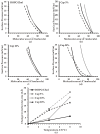Effects of Capsaicin on Biomimetic Membranes
- PMID: 31105202
- PMCID: PMC6477667
- DOI: 10.3390/biomimetics4010017
Effects of Capsaicin on Biomimetic Membranes
Abstract
Capsaicin is a natural compound that produces a warm sensation and is known for its remarkable medicinal properties. Understanding the interaction between capsaicin with lipid membranes is essential to clarify the molecular mechanisms behind its pharmacological and biological effects. In this study, we investigated the effect of capsaicin on thermoresponsiveness, fluidity, and phase separation of liposomal membranes. Liposomal membranes are a bioinspired technology that can be exploited to understand biological mechanisms. We have shown that by increasing thermo-induced membrane excess area, capsaicin promoted membrane fluctuation. The effect of capsaicin on membrane fluidity was dependent on lipid composition. Capsaicin increased fluidity of (1,2-dioleoyl-sn-glycero-3-phosphocholine (DOPC) membranes, while it rigidified DOPC and cholesterol-based liposomes. In addition, capsaicin tended to decrease phase separation of heterogeneous liposomes, inducing homogeneity. We imagine this lipid re-organization to be associated with the physiological warming sensation upon consumption of capsaicin. Since capsaicin has been reported to have biological properties such as antimicrobial and as antiplatelet, the results will help unravel these biological properties.
Keywords: capsaicin; liposomes; membrane excess area; membrane fluctuation; membrane fluidity; phase separation; thermoresponsiveness.
Conflict of interest statement
The authors declare no conflict of interest. The funders had no role in the design of the study; in the collection, analyses, or interpretation of data; in the writing of the manuscript, or in the decision to publish the results.
Figures




References
LinkOut - more resources
Full Text Sources

